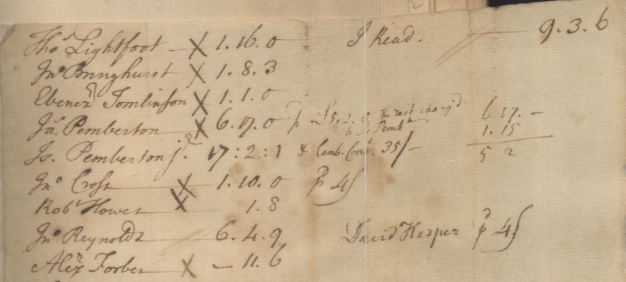Who’s Who in the Franklins’ Shop Books?
The Franklins’ Philadelphia Ledgers Project, a multi-phase project created by the Center for Digital Scholarship at the American Philosophical Society, recently launched its second phase, making the shop books that Benjamin Franklin and his wife Deborah Read Franklin kept over the early years of their business accessible to the public online. As part of the project, all of the ledgers we have transcribed to date have been compiled into a searchable database, allowing users to compare information from different sources with relative ease. Through this database, users can access three of the account books kept by the Franklins as well as several of Benjamin Franklin’s postal ledgers in a unified interface.
To enhance the usability of this resource, we wanted to provide every individual in the ledgers with a unique identifier. This would allow users to pull up all the transactions under one person with a single click. However, this was no easy task. Many people in the ledgers are identified inconsistently, by nicknames, or by first or last name only. When the Franklins only refer to someone as “Mrs. Staples” or “Mary," it is difficult to figure out who these people were.
Fortunately for us, Franklin scholar Leo Lemay had already done a great deal of work for us. Lemay’s “The Accounts of Benjamin Franklin Through 1747” contains a name index that disambiguates many of the names in the account books. We used this as this basis for our own index of people in the ledgers, augmenting Lemay’s work with the individuals in the postal ledgers.
While some of the people identified in the name index are well-known historical figures, others are people who we may never identify concretely. Often, the most problematic entries are those where the Franklins use nicknames to refer to their customers. While these names may make identification difficult, they nonetheless provide insight into how the Franklins ran their shop and also show a more humorous side of their business. Here are some of my favorites.

In Ledger A, Benjamin Franklin recorded two transactions with “My Madman” or “the Madman,” who purchased a bottle of ink and some miscellaneous goods. Franklin notes that these transactions were “taken out of Mrs. Read’s shop book,” referring to Deborah Franklin’s mother. Perhaps Franklin himself was unaware of who his mother-in-law was referring to.

In the Shop Book, Deborah Franklin recorded one transaction with “Mary the Papist that is at Coson Wilkinsins.” Mary purchased a testament and a pair of indentures. Whether the Franklins openly referred to Mary with this epithet is uncertain, but this curious figure who was apparently staying with Deborah’s cousin Anthony Wilkinson does not appear anywhere else in the ledgers.

The last example is a two-for-one! In the Shop Book, Deborah Franklin recorded two interactions with “the Dockter that mareyed Duch Nancy,” who purchased three dozen almanacs from the Franklins. We haven’t found any information on who this doctor could be, nor do we know anything about the woman he married. Nancy, presumably a German woman due to the presence of the word “Dutch”, purchased a dozen almanacs, some ink, and some paper from Deborah Franklin.
In making these manuscripts available to the public as data, we hope to encourage further research on the individuals who interacted with the Franklins. Perhaps future users of the database will be able to identify these people and solve some of these mysteries.

